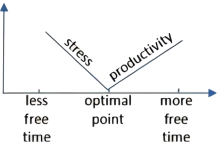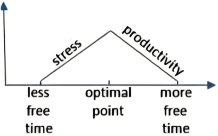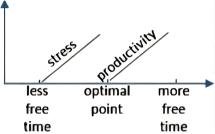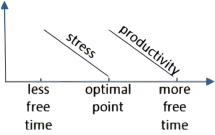2 . Up and down the economic ladder, many Americans who work—and especially those raising kids—are pressed for time, wishing they had more of it to devote to leisure activities (or even just sleeping). At the same time, research has indicated that people who are busy tend to be happier than those who are idle, whether their busyness is purposeful or not.
A research paper released late last year investigated this trade-off, attempting to pinpoint (精确指出) how much leisure time is best. Its authors examined the relationship between the amount of “discretionary time” people had—basically, how much time people spend awake and doing what they want—and how pleased they were with their lives.
The paper, which analyzed data covering about 35,000 Americans, found that employed people’s ratings of their satisfaction with life peaked when they had in the neighborhood of two and a half hours of free time a day. For people who didn’t work, the optimal (最佳) amount was four hours and 45 minutes.
The research traced a correlation (关联) between free time and life satisfaction, but didn’t provide any definitive (最后的) insight into what underlies that correlation—“which is exciting, because this is a work in progress,” says Cassie Mogilner Holmes, a professor at UCLA’s Anderson School of Management and a co-author of the paper, which hasn’t yet been peer-reviewed or published in an academic journal.
An experiment that the researchers arranged hinted at (暗示) a possible explanation of the correlation they found. They asked participants to picture and describe what it would be like to have a certain amount of daily free time, and then report how they’d feel about that allotment (分配). “What we find is that having too little time makes people feel stressed, and maybe that’s obvious,” says Holmes. “But interestingly, that effect goes away—the role of stress goes away—once you approach the optimal point.” After that point, Holmes says, the subjects started to say they felt less productive overall, which could explain why having a lot of free time can feel like having too much free time.
It’s not clear what an individual is to do with these findings, since the amount of free time people have usually has something to do with a variety of factors, such as having children or a degree of control over work schedules. Holmes shared her research with the MBA students in her class on happiness, and some of the most time-crunched among them were comforted by the findings: “I think that two and a half hours creates a nice goal that even if you increase a little bit more of your discretionary time use, you can expect that it will translate into greater life satisfaction.”
1. According to the passage, what happens to Americans occupied with their work?
| A.They allow themselves more leisure time. |
| B.They keep themselves busy on purpose. |
| C.They know how much leisure time is best. |
| D.They experience higher level of satisfaction. |
2. What can be learned about the correlation between free time and life satisfaction?
| A.Researchers have cast light on the cause of the correlation. |
| B.Unemployed people need more leisure time to feel content. |
| C.The paper on the correlation has achieved peer recognition. |
| D.Employed people enjoy more leisure time in the neighborhood. |
3. Which of the following charts illustrates the change of stress and productivity?
4. It can be inferred from the last paragraph that _______.
| A.Holmes is optimistic about the influence of her findings |
| B.individuals are encouraged to control their work schedules |
| C.people with tight schedules can’t benefit from the findings |
| D.the MBA students find no free time to obtain life satisfaction |







